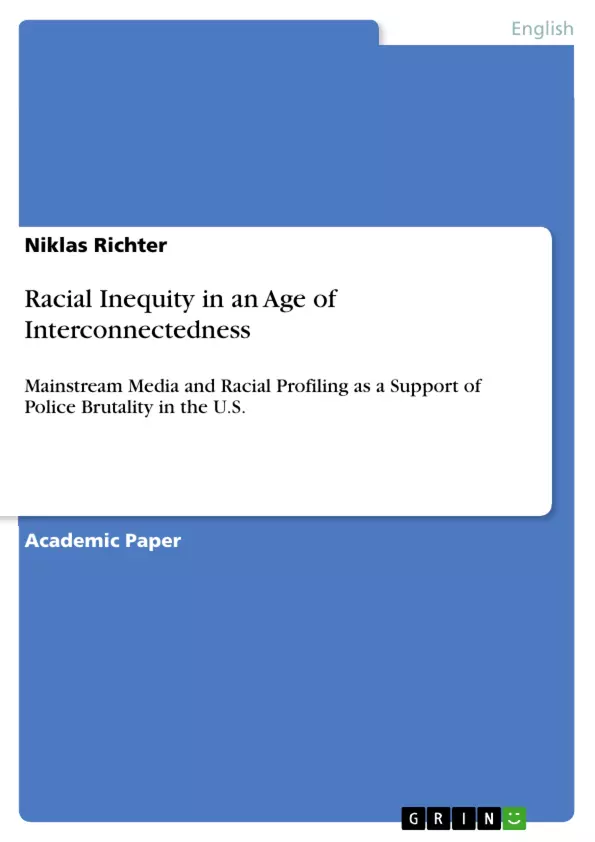While it has already been established that police officers in the U.S. still discriminate against people of colour by enacting police brutality, thus enabling institutional racism to flourish, mainstream media contribute in a similar manner by perpetuating depictions of the criminal black male and with that supporting the idea of racial profiling. To make it easier for the reader to identify my stance, providing the necessary explanations for the terminology, as well as clarifying the historical context through which racism is enrooted in the history of the U.S. will guide the reader along the mass racial violence that will be discussed. In the main part, a thorough analysis of two incidents of police brutality, one being the case of Martin, the other one being Brown’s case, shall be established. Finally yet importantly, examining the influence of media shall help to either justify or falsify my thesis on this matter, before I end with my conclusion.
Table of Contents
- Introduction
- Historical Context and Theory
- Terminology Associated with Racism
- Historical Context
- Analysis of Exemplary Police Brutality Cases and Their Presentation by the Mainstream Media
- The Death of Trayvon Martin
- The Death of Michael Brown
- Conclusion
Objectives and Key Themes
This paper examines the interconnectedness of mainstream media representations and racial profiling in perpetuating police brutality against people of color in the United States. The author aims to demonstrate how media portrayals contribute to the normalization and acceptance of such violence by reinforcing negative stereotypes. The analysis focuses on specific cases of police brutality to illustrate this connection.
- Police brutality as a manifestation of systemic racism
- The role of mainstream media in shaping public perception of people of color
- The perpetuation of negative stereotypes through media representations
- The historical context of racial inequality in the U.S. and its impact on contemporary events
- The relationship between racial profiling and police violence
Chapter Summaries
Introduction: This introductory chapter sets the stage for the paper by citing a quote from Malcolm X highlighting the historical complicity of media in covering up police brutality against Black Americans. The author establishes the central argument: that mainstream media perpetuates depictions of the Black male as criminal, thereby supporting racial profiling and enabling police brutality. The chapter outlines the structure of the paper, promising an examination of terminology, historical context, and detailed analyses of the deaths of Trayvon Martin and Michael Brown, followed by an assessment of media influence.
Historical Context and Theory: This chapter delves into the theoretical framework underpinning the paper. It provides definitions of police brutality, racism, and institutional racism, drawing on scholarly sources to clarify these key terms. The chapter establishes a link between police misconduct and racism, arguing that institutional racism manifests in biased treatment within the criminal justice system. It further explores how negative media portrayals of Black males influence public perception, contributing to the perpetuation of systemic racism and justifying harsher treatment within the justice system. The author connects these concepts to the historical context of U.S. imperialism and colonialism, illustrating how the image of the Black convict has persisted throughout history.
Keywords
Police brutality, racial profiling, mainstream media, systemic racism, institutional racism, negative stereotypes, Trayvon Martin, Michael Brown, criminal justice, media representation, historical context.
Frequently asked questions
What is the main topic of the text?
The text analyzes the interconnectedness of mainstream media representations and racial profiling in perpetuating police brutality against people of color in the United States.
What are the key themes discussed?
The key themes include: police brutality as a manifestation of systemic racism; the role of mainstream media in shaping public perception of people of color; the perpetuation of negative stereotypes through media representations; the historical context of racial inequality in the U.S.; and the relationship between racial profiling and police violence.
What cases of police brutality are examined in detail?
The text focuses on the deaths of Trayvon Martin and Michael Brown as exemplary cases of police brutality and analyzes their presentation by the mainstream media.
What is the author's main argument?
The author argues that mainstream media perpetuates depictions of Black males as criminals, thereby supporting racial profiling and enabling police brutality.
What terminology is defined in the text?
The text provides definitions of police brutality, racism, and institutional racism, drawing on scholarly sources.
What is the historical context discussed?
The text connects the concepts of police brutality and racism to the historical context of U.S. imperialism and colonialism, illustrating how the image of the Black convict has persisted throughout history.
What keywords are associated with the text?
The keywords include: Police brutality, racial profiling, mainstream media, systemic racism, institutional racism, negative stereotypes, Trayvon Martin, Michael Brown, criminal justice, media representation, historical context.
What does the introduction chapter outline?
The introduction cites Malcolm X and establishes the argument that mainstream media perpetuates criminal depictions of the Black male, supporting racial profiling and police brutality, the chapter outlines the structure of the paper, examining terminology, historical context, analyses of the deaths of Trayvon Martin and Michael Brown, and an assessment of media influence.
What does the historical context and theory chapter discuss?
The chapter discusses police brutality, racism, and institutional racism, as well as their historical context and related theories.
- Quote paper
- Niklas Richter (Author), 2020, Racial Inequity in an Age of Interconnectedness, Munich, GRIN Verlag, https://www.grin.com/document/1586948



